February 20th, 2018 -
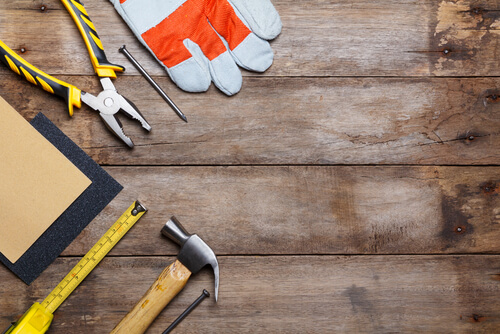
When you’re traveling in your RV on the open road, you’re subject to plenty of freedom and independence. That independence means that you need to be able to handle problems yourself, if they arise. It’s part of the territory. To that end, there are certain tools that are pretty much required for RV travel. You may never need them, but you could be really sorry one day if you don’t have them aboard.
Tire Gauge
This one’s going to get used frequently. A tire gauge allows you to monitor the air pressure of your tires and to keep them at optimal levels as you travel. Properly inflated tires are more resilient, last longer, and will provide you with better fuel economy, which an RVer can appreciate.
Axe
A quality axe provides a multitude of useful functions around any RV site or campground. From cutting up wood for a fire to clearing debris, an axe is never dead weight. Consider packing it or a hatchet when you go out hiking. If you get lost somehow, it’s among the most useful items you can have.
Multi-bit Screwdriver
Instead of owning a dozen screwdrivers, invest instead in a multi-bit version. The various heads all magnetically snap into the handle and give you all the utility of a drawer full of lesser screwdrivers. No matter what kind of screw you encounter, a multi-bit has got you covered.
Channel Lock Pliers
Channel lock pliers will serve as your go-to tool for all things plumbing-related. From tightening a water hose to turning on a spigot that’s missing a handle, they’ll serve you well any time you need to really tighten something or need a makeshift handle.
Needle Nose Pliers
The pliers to use when something requires a bit more finesse. Needle nose pliers can fit into tight spaces and give you fine control over something too small for your hands to properly manipulate.
Visit PleasureLand RV Center
If you’re interested in starting the RV lifestyle, come see us at PleasureLand RV Center. Our wide inventory of RVs and motorhomes is sure to have just the right model for your needs. If you have any questions on driving an RV, we’d be glad to help!
January 25th, 2018 -
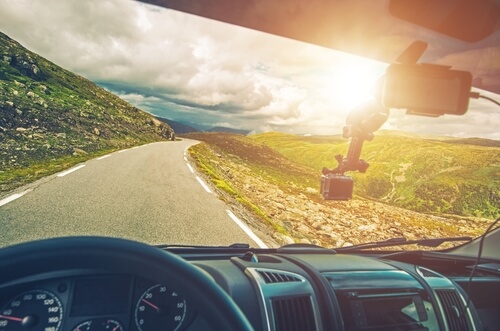
If you want to guarantee that your next vacation will be one of the best ones yet, rent an RV. Renting and RV gives you the opportunity to cater your travels directly to your needs. Whether you want to relax on the beach or enjoy an epic adventure, an RV will get you to your destination and ensure you enjoy the journey along the way.
Enjoy the Affordability
Renting an RV eliminates your need for pricey plane tickets, numerous costly hotels rooms and expensive meals at restaurants. For one low daily rental rate, your travel, accommodations and even a convenient kitchen are included. Renting and RV will cut your vacation expenses associated with flights, hotels and restaurants roughly in half.
Use Your Freedoms
One of the biggest perks of renting an RV is that you enjoy freedoms that you don’t experience when flying to your destination. Flight times, layovers, TSA checkpoints and canceled flights are things of the past, and expensive and unhealthy meals can be exchanged for your favorite homemade alternatives. An RV rental even lets you change your travel plans if you see a stop (America is known for its outrageous roadside attractions) you want to make along the way. There are no set rules, schedules, or reservations.
Spend More Time Together
An RV rental encourages your family to spend more time together. Whether you’re on the road to your destination, eating meals, enjoying recreational activities outside or lounging at the campsite, an RV keeps your family together much more often than separate hotel rooms. You’ll be amazed at how many lifelong memories are made inside your rental RV.
Rent Your RV from PleasureLand
PleasureLand RV Center makes your RV rental experience quick, easy and affordable. Choose from a Class A, Class C, travel trailer, pop-up or ice house rental that you can pick up or drop off at our St. Cloud, Brainerd, or Willmar locations. Log online to find out more about all of our RV rental options and prices.
January 16th, 2018 -
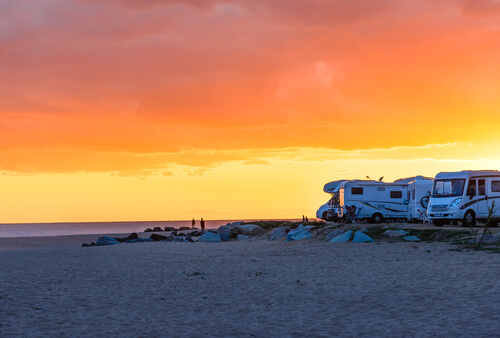
Determining which type of RV will suit your needs best can seem impossible. With so many RVs on the market, ranging from pop-up campers to high-end Class A motorhomes, choosing from such a large number of models can be daunting. These simple tips will help you discover which type of RV is perfect for you, so you can narrow down your options and start living your dream RV lifestyle.
Determine Your RV Use
The first step to choosing an RV is to determine which type of traveling you’d like to do. Are you seeking an RV for weekend family getaways or an RV that will replace your brick-and-mortar home? Do you want to move from one destination to another or stay put for months at a time? Typically, smaller, more budget-friendly RVs can be suitable for recreational weekend campers, while those who want to spend more time on the road should seek RVs with more durability and amenities.
Motorhomes are more ideal for travelers who like to stop in multiple places. Because they don’t take a lot of time to set up and prepare for departure (unlike fifth wheels and travel trailers), it’s easy to hop from one destination to another.
Consider Your Tow Vehicle
Many first-time RV enthusiasts forget that they may need to upgrade their tow vehicle to a more powerful model to tow a large travel trailer or fifth wheel. This can add a considerable amount of cost to upgrading your RV lifestyle and should always be considered. However, these more spacious RVs also offer more amenities, such as full bathrooms, fully-equipped kitchens, more seating space and quality sleeping areas.
Let Us Help
Here at PleasureLand RV Center, we’re experts on helping you find an RV that’s ideal for your travel needs. We’ll work within your budget to help you start the RV lifestyle you’ve been dreaming about for years.
December 9th, 2017 -
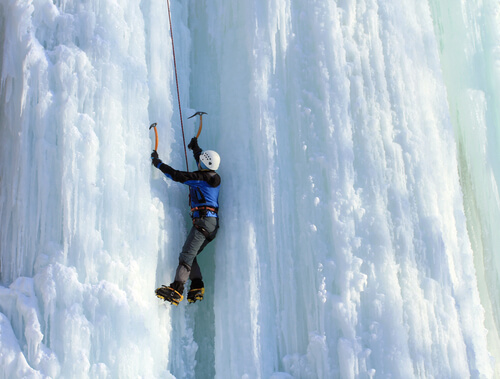
Climbing is often viewed as a dangerous, adrenaline-pumping activity that only the most physically strong and skilled people are able to do. Adding ice to that mix? You may want to say “forget about it,” but ice climbing is, in reality, less about physical strength and climbing skills and more about thinking and patience. It’s also a lot more safe than you probably assume so long as you practice tried and true safety precautions when you climb.
If you’re curious about giving ice climbing a try this winter in Minnesota while you travel about in your RV, you’re going to want to learn how to do it from someone experienced. It’s not advisable that you try ice climbing by yourself if you have no experience. Minnesota actually has two great opportunities to learn in annual climbing festivals: the Sandstone Ice Festival and the Duluth Ice and Mixed Fest.
The Sandstone Ice Festival is scheduled from January 5 through 7. It’s been going for over a decade now and is held in Robinson Park, which is the first park in Minnesota set aside specifically for ice climbing. It has climbing opportunities for any skill level, but more importantly it’s got beginner courses to teach you about safety, the climbing equipment you need, and the basic movements to get you up an ice cliff.
Happening later in the season, the Duluth Ice and Mixed Fest is scheduled for February 2 through 4. It’s a newer festival, but offers the same benefits as Sandstone. The event takes place in Duluth at Casket Park.
Visit PleasureLand RV Center
Before you hit the roads this holiday season, bring your RV by PleasureLand RV Center in Minnesota to ensure it’s in top shape for the winter roads. And if you’re in the market for a new or used RV, stop in or log online to browse our huge selection of top-quality RVs in stock.
December 5th, 2017 -
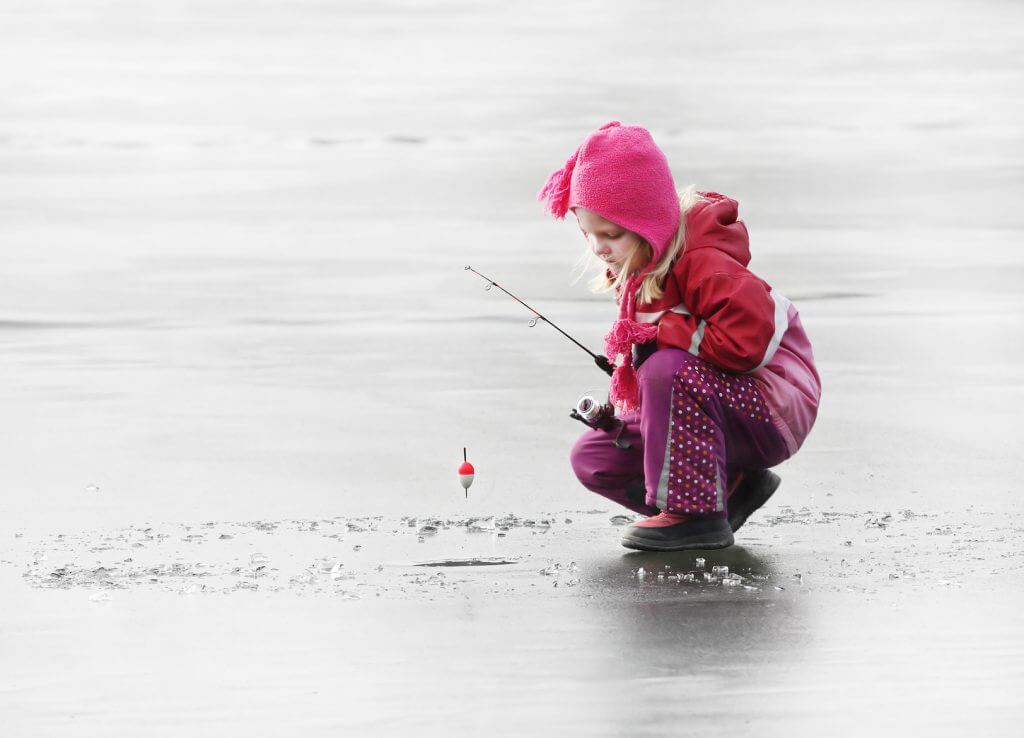
Minnesota’s more than 11,800 lakes make it a hotspot for ice fishing. However, having so many places from which to choose can make planning your getaway more difficult. These three places to ice fish around Minnesota are some of the best of the best for catching fish and enjoying your stay.
Mille Lacs
St. Paul residents don’t have to travel far to find some of the country’s best ice fishing. Minnesota’s second largest lake, Mille Lacs, offers 74 miles of coastline and numerous access points to make your fishing excursions more convenient. The lake’s more than 130,000-acre size also means fishermen have plenty of room to spread out. The lake is known to be home to an abundance of rock bass, walleye, northern pike, small mouth bass, jumbo perch, tullibee and muskie, so bring a large cooler for your catch.
Gull Lake
Gull Lake is known across Minnesota as one of the best fishing spots. It’s home to the annual Ice Fishing Extravaganza event, which is the largest ice fishing event in North America. This fishing spot in the Brainerd Lake Region offers great water quality, which sustains huge populations of northern pike, bluegill, walleye, rock bass, largemouth bass and crappie. Park your RV in nearby Nisswa or Brainerd to enjoy a little bit of off-the-ice action during your stay.
Upper Red Lake
Red Lake is the largest lake in Minnesota, and it’s a hotspot for world-class fishing conditions. Head to the lake’s upper region to enjoy the best walleye fishing in the state. However, don’t be surprised if you reel in some crappie and northern pike too. The entire lake is 288,000 acres in size, so you’ll never feel like you’re fishing in a crowd.
Stop and See Us
Minnesota’s PleasureLand RV Centers are located near some of our state’s best ice fishing spots. We’re offering a huge selection of ice houses on sale for the holiday season, so log online or stop in and see us today.
November 9th, 2017 -
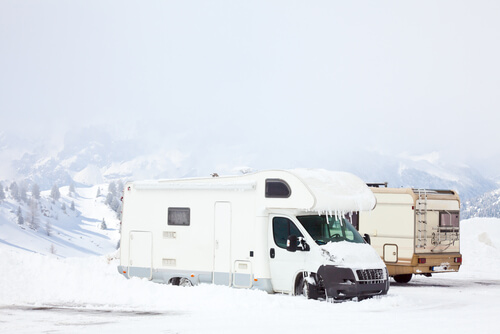
RVs aren’t typically designed for frigid weather. However, that doesn’t mean you have to own a costly four-seasons RV to stay warm in cold destinations. These few, helpful tips will ensure you stay warm when you’re venturing throughout the country this fall and winter.
Keep Drafts at Bay
RVs have a tendency to feel drafty, and small leaks are what cause those drafts. Use silicone rubber or spray foam insulation to patch those tiny spots where cold air is seeping inside.
Larger drafts require larger treatments. Insulated “snakes,” or the long, stuffed insulating tubes you see at the hardware store, help keep warm air inside when placed in doorways. Painters’ tape is another easy fix for temporary use. Place the tape over the leaks behind your appliances and cabinetry for short-term stays in cold destinations.
Keep the Shades Closed
Another easy way to keep the interior of your RV warm in the winter months is to keep your curtains and shades closed. Closing the shades will trap a layer of air between the shade and the window that serves as an insulator. It won’t warm your RV to a higher temperature, but it will keep the temperature from dropping rapidly.
Use Plenty of Rugs
Waking up in a cold RV can be dreadful, especially when you know you have to walk along laminate floor. Use throw rugs to insulate the floors of your RV more thoroughly and save your feet from those freezing winter mornings.
Consider a Space Heater
A quality ceramic space heater can make the difference between comfort and discomfort in the cold months. Use the space heater in addition to your RV’s furnace to assist the furnace and save you big bucks on hefty propane costs.
Upgrade Your RV
Here at the PleasureLand RV Centers in Minnesota, we know all of the tricks — big and small — to helping you stay warm in your RV in the winter. Give us a call, log online or stop in and see us to upgrade your RV for the winter ahead.
September 7th, 2017 -
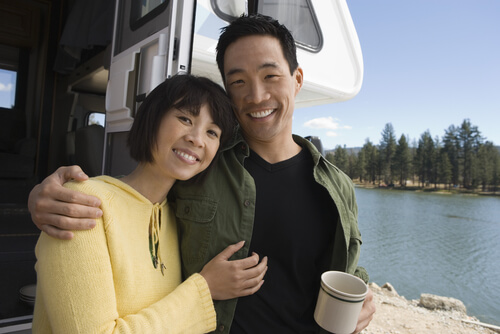
Traveling the country in your RV with a partner is one of the most enjoyable things in the world… or one of the most frustrating! Depends on the day, really. While you might get along most of the time, there’s something about being in close proximity with another person for days, weeks, or even months without pause that can really leave you feeling like your buttons are being pushed.
RVs mean unrivaled intimacy due to the face that they’re both your means of travel and your living quarters all in one compact package. To prevent yourself from becoming tired of your partner, it’s important to practice certain habits to distance yourself when need be.
Headphones Are Everything
There’s nothing better at creating an immediate barrier between yourself and another person than a good pair of headphones. Whether you need to cool off or simply need some alone time, headphones provide it. Listen to some music you like, catch up on an audiobook or podcast, or watch some videos. After some “alone” time, you can rejoin your partner by simply pulling the earbuds out.
Have Your Own Interests
Sure you’re traveling together and doing pretty much everything else together, but you should definitely bring along some personal hobbies with you on the road. Just like practicing them at home, your hobbies allow you to have that stress relief that only comes from doing something you love on your own. Whether it’s calligraphy, photography, writing, scrapbooking, knitting, or whatever else, don’t leave your hobbies behind.
Keep Lines of Communication Open
No matter how annoyed you are or even angry, it’s crucial that you keep communication open with your partner. While the silent treatment might sound appealing, there’s no chance that fences will be mended if you don’t talk. On that note, don’t stay angry with your partner. You’re on the road with them with nowhere to go, so make the best of any situation and let go of any anger you’re harboring.
Visit PleasureLand RV Center
Stop by PleasureLand RV Center this fall to tour a new or used motorhome or travel trailer. Find one that’s perfect for you and your travel plans this fall. If you’re not on the market for an RV, you can still stop in at PleasureLand RV Center to schedule service, to learn more about RVing, or to shop for parts and accessories.
August 31st, 2017 -
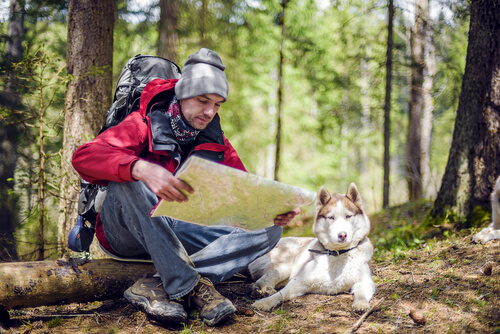
When you’re packing for an RV trip, whether it’s a short weekend trip or a long trip, you definitely don’t want to forget anything. And when you are bringing your pet with you, you definitely don’t want to forget anything, especially the dog’s food or leash. Be sure to make a list of everything you need for yourself, your family and your pet. And, keep in mind that your pet has additional travel needs.
Stopping More Often
If you are bringing your dog with you and you would like to be at a certain destination by a certain time, you’ll need to add some extra time to the trip. While you might be able to go eight hours without stopping, your pets may not be able to make it that long. Plan on stopping for about 15 minutes every 3 hours to give your pet a break. Never let your pet ride in a trailer.
Providing Water
If you are not providing your pet with water in the vehicle, you’ll need to give it a drink whenever you stop, in addition to the bathroom break.
Food
If the trip is more than eight hours and you plan on driving through, be sure to feed your pet. If you normally feed your pet more than once a day, plan stops that are close to its regular feeding time. If your pet normally eats just once per day, but is used to having snacks throughout the day, be sure to bring its treats in the vehicle with you.
Car Sickness
If your dog tends to get car sick, check with your vet for the dosage of Dramamine it can have. You’ll want to give your dog the medication at least a half hour before you start the trip. Ask your vet how long a dosage should last and when you should re-medicate while you are on the road.
Weather
If you are traveling from a warm climate to a cold climate and your dog normally wear sweaters when it’s cold, be sure to pack a sweater in the vehicle with you so that you don’t have to stop to look for it in the trailer or back of the RV.
Visit PleasureLand RV Center
Stop by PleasureLand RV Center to walk through our floor plans if you are ready for a new RV; or to pick up any RV accessories you might need for your trip.
August 24th, 2017 -
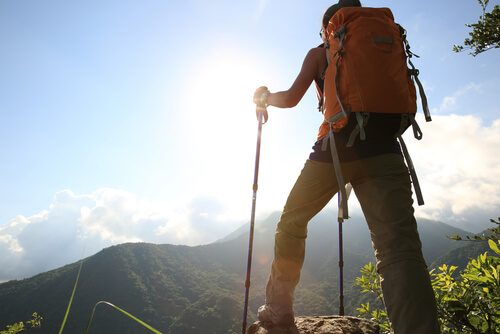
If you’re a beginning hiker that’s never used trekking poles, it may be because you’re not sure what to make of them. What advantages do they confer and are they right for your hikes? If you’re thinking about acquiring a pair and taking them out on your next hike, here’s how to make the most effective use of them.
They Help Support You
Just like a walking stick, trekking poles times the advantage by two. They’re especially useful on treacherous terrain, like loose gravel, wet rocks, or when fording shallow creeks. Not only do they help keep you upright, but they also promote good posture that in turn helps you shoulder your pack better. By putting some of your weight onto the trekking poles via your arms, you take some of the stress off of your legs and back. When you get tired later during an all day hike, you can also rely on them more and more to support you even when your knees are getting tired.
They Come in Handy in Ways You Wouldn’t Expect
Having some trekking poles on hand can be unexpectedly beneficial. They can serve as arm extensions if you need to poke something from a distance or attempt to bring something closer. Not that we recommend battling wildlife, but in a pinch they can be used to ward off an aggressive animal when escape isn’t possible.
Visit PleasureLand RV Center
There’s no better way to travel to your favorite Minnesota hiking trails than in the comfort and convenience of your RV. Stop in and see us at one of our many Minnesota PleasureLand RV Center locations to start your new RV lifestyle today.
July 27th, 2017 -
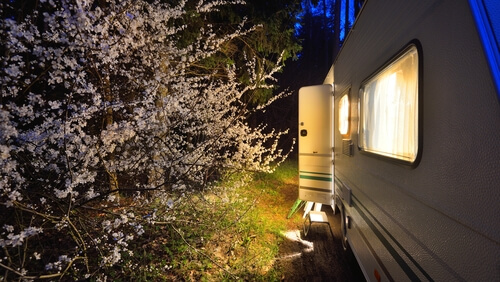
If you just bought an RV from PleasureLand RV Center this summer and it’s your first time out in your new RV, you may be daunted by the idea of setting up your RV at the campsite or RV park.
We’ve got you covered – here’s everything you need to know when setting up at your destination.
Getting to Your Assigned Spot and Getting Your Rig Situated
It’s pretty standard to check-in at the campsite or RV park front office just like you would at a hotel. When you get there, you can ask if they’ve got an escort service. This serves to not only guide you to where your site is located, but they’ll be able to help you get your RV setup as well, including getting it parked and leveled.
Once you get there, regardless of an escort, you’ll need to either back your RV up or pull it through. Whether it’s back up or pull through, just make sure that your hookups are roughly aligned with their outlets at the site.
Once you’re satisfied with your positioning, apply the parking brake if you’re in a motorhome.
Now it’s time to level your RV. Not all sites will be perfectly flat, so use blocks and stabilizing jacks to get your RV flattened out. Once that’s done, chock the wheels so that there’s no chance your RV will slide or roll.
Next, go ahead and extend steps, slide-outs, and awnings.
Water and Power
Connect your electric cord to the site’s outlet that matches your RV’s required amperage and don’t forget to switch your fridge from propane to electric or you’ll run out of propane real fast.
Your site ought to have at least a clean water hookup, but many also have sewage. Ask for help if you’re unsure how to connect your RV to these hookups.
Make Yourself Comfortable
Now it’s up to you to make your site feel like home. This part is up to you, but you might want to set out some lawn furniture, mats, decorations, etc.
Visit PleasureLand RV Center
Stop by PleasureLand RV Center this summer to tour a new or used motorhome or travel trailer and to learn more about the RV lifestyle. If you’ve got questions on how to operate your RV, we’ll be happy to help.
|
|
About Me
Hi, my name is Dan Pearson and I am the Owner of PleasureLand RV Centers based out of St. Cloud, MN. We have three other Minnesota locations to serve all of you RV needs. I look forward to providing you with all your RV information from buying an RV to tips and maintenance. If you would like to contact me, be sure to leave a comment.
|










